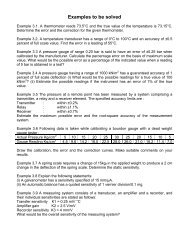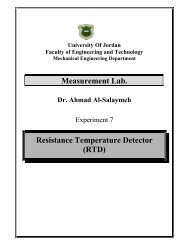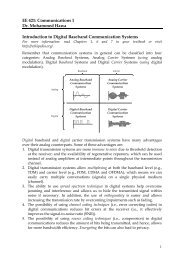Simulation of Third Generation CDMA Systems - Virginia Tech
Simulation of Third Generation CDMA Systems - Virginia Tech
Simulation of Third Generation CDMA Systems - Virginia Tech
Create successful ePaper yourself
Turn your PDF publications into a flip-book with our unique Google optimized e-Paper software.
IT+ τT + τi i i I iτ iτ iiiz = h( t-τ ) d ( t- τ ) dt + Re{ I ( t)} C ( t-τ) dtIIT + τi I ii+ Re{ n ( t)} C ( t-τ) dtτii I i(3.22)Here T is the symbol period. If we assume that the magnitude response <strong>of</strong> the channelremains constant for the symbol interval, we getI IT + τT + τi i i I iτ iτ iiiz = Th K+ Re{ I ( t)} C ( t- τ ) dt+ Re{ n ( t)} C ( t-τ) dti I i(3.23)Here K can be either 1 or –1 depending on the transmitted symbol. The second termin equation (3.22) is ISI. Because <strong>of</strong> the processing gain, the ISI is pretty small compared thefirst tem <strong>of</strong> the equation (3.22). The third term here is the noise term.The above analysis can be extended to take the presence <strong>of</strong> MAI into account.Equation (3.22) will be modified as a fourth term corresponding to MAI will be added.3.3 Downlink SimulatorAt the downlink, the mobile station receiver receives the signal transmitted by thebase station transmitter. The MS receives the desired signal along with signals transmitted bythe base station for other mobile stations at the system. The block diagram <strong>of</strong> the downlinksimulator is shown in Figure 3.17.The downlink simulator differs from the uplink simulator in the generation <strong>of</strong> MAI.The frame structure and the spreading and modulation are a also modified from the up link.47
















